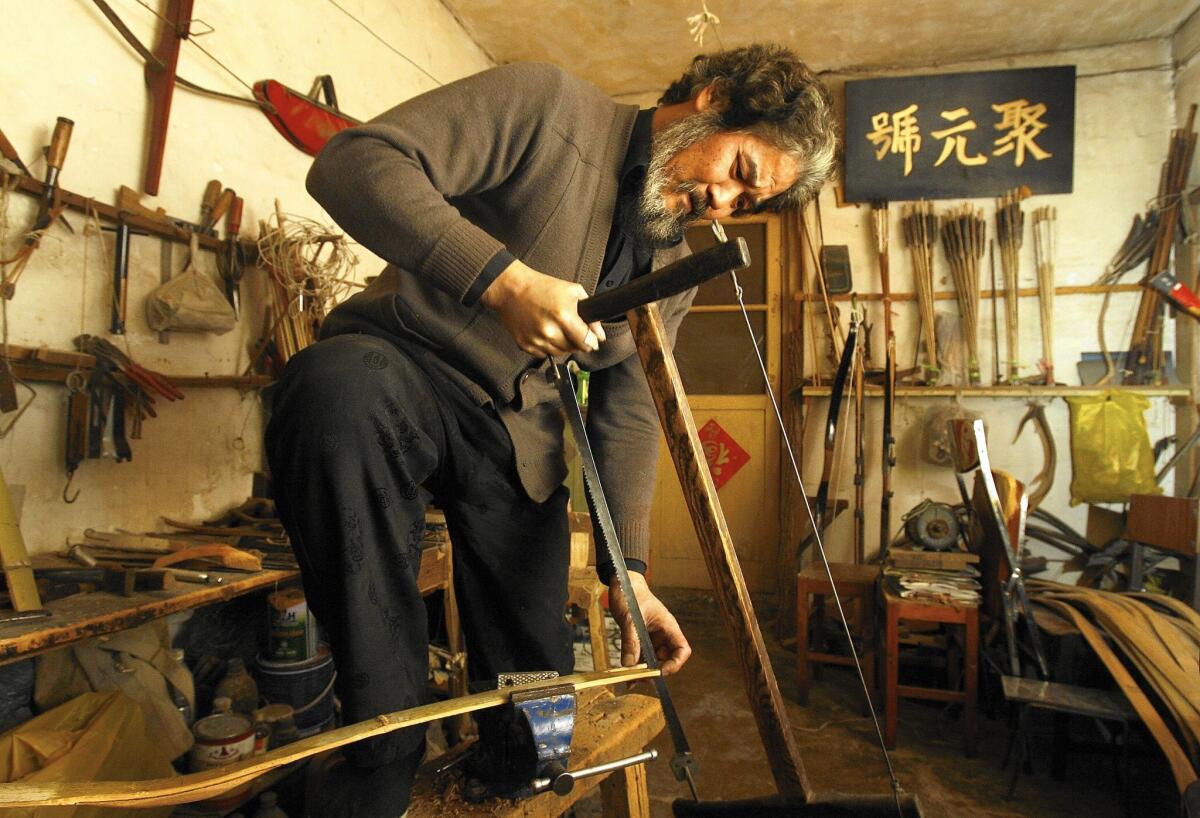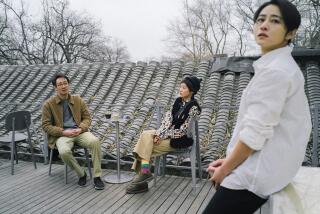In China, a traditional bow maker finds his calling in ‘noble art’

Even after half a century, Yang Fuxi can still remember the pungent smell of his grandfather’s bow and arrow workshop in central Beijing.
“There was the odor of glue and bull horn when you grind it, almost a burning scent as if you are stewing something and run out of water,” Yang said.
“Worst was the snake skins,” he continued. “It’s a fishy, stinky smell. Even if a dog were walking by, he would try to avoid it.”
In ancient China, the craft was considered one of the six “noble arts,” along with rites, music, chariot racing, mathematics and calligraphy. Founded in the 1700s, Ju Yuan Hao, as the business was named, operated out of the Forbidden City for its first century, providing bows and arrows to the imperial court.
By the 1950s firearms had cost bow-making much of its indispensability, but the famed archers of Mongolia were still frequent customers.
“My father would go to the Mongolian Embassy in Beijing and collect a check,” said Yang, 58. “We were quite well-off.”
But as China’s communist revolution intensified, Mao Tse-tung’s administrators decreed that the shop be turned into a factory making sports equipment.
In 1966, when Yang was 8, Mao sent Red Guards house to house on a quest to destroy any vestiges of ancient Chinese civilization. One night, fearing for the family’s safety, Yang’s father and brother bundled up perhaps 100 of the traditional weapons and dumped them in the countryside.
They saved just one, made in the 1820s to commemorate the 100th anniversary of the shop’s founding.
His father cut the bow in half, wrapped it in plastic and stashed it under a pile of firewood.
Decades later, those bows still called powerfully to Yang.
In aiming to wipe out the past, the Cultural Revolution also stole the futures of boys such as Yang.
He had just started elementary school when classes were suspended for four years. When they resumed, he learned to read Chinese, but most of the time, he said, was spent “criticizing counterrevolutionaries.”
In high school, he was assigned to work part time in a factory and later, like many urban teenagers, he was sent to toil in the countryside.
Starting at age 21, he worked for 13 years in a Beijing chemical factory, dealing with chlorine and other substances. “I joined the factory because I had to survive,” he said. “Without that work, I couldn’t feed myself.”
When the factory acquired some new vehicles, Yang hoped to be assigned to drive one. When that didn’t work out, he got in a physical fight with his boss, then quit and became a taxi driver. That lasted several years, until Yang, an amateur philatelist, got in another dust-up with a manager who touched some of his stamps.
He was 40 and needed a change.
A few years earlier, after the Communist Party declared the Cultural Revolution a grave error, Yang’s father had restored the one bow he had saved and began talking fondly about the craft over dinners.
Yang began to wonder whether the old family business was the answer to his employment troubles. He remembered something his grandfather once told him: “If you can make something, you’ll never starve.”
Finally, he quit his job and told his father he wanted to be a bow maker.
“There was no excitement, no happiness,” Yang recalled. “In part because he thought it was so normal — because he thought that’s what I should be doing all along.”
At the same time, his parents tried to talk him out of it. “They said it would be exhausting,” he said.
Yang refused to reconsider. “I wasn’t afraid, because I had worked in the countryside for two years during high school,” he said. “That was the hardest thing ever.”
Yang’s father agreed to teach him all he remembered.
After a few months, he attempted making a standard, unadorned bow. He worked alongside his father, copying his technique.
Fashioning a bow entails about 200 steps, starting with shaping bamboo or other wood into an arc. There are no measurements, no schematic drawings — craftsmen like Yang work by intuition.
“None of the raw materials can be bought easily in the market,” Yang said.
Water buffalo horn and sinew. Fish skin, donkey skin, snake skin. The bark of birch trees. Pig glue. Silk.
“We used to get the water buffalo horn here in China, but now we have to go to Vietnam or Cambodia,” he said. “Hardly anyone here in China uses water buffaloes anymore.”
The horn is glued to one side for stability. The sinew is applied in layers on the opposite side for strength and flexibility. Some bows get as many as nine applications of sinew. Above the grip, where the arrow’s shaft rubs the bow, fish skin is wrapped to protect the contact point.
Birch bark and snake skin are applied as decorative elements. Painted motifs including bats and dragons are added, transforming the weaponry into functional objects of art.
These men are very few and far between. Yang Fuxi is a man standing with one foot in the past and the other in the present. It’s quite extraordinary.
— William Lindesay, British historian and author
Then there are the subtleties of the craft. “When the weather is great, like now, pretty dry, it will still take more than a week to complete each layer,” Yang said. Drying time is longer in humid conditions.
Although he took well to the work, finding customers was another matter. “For the first four years, from 1998 to 2002, I really made no money,” he said.
Then in 2003, a doctoral student writing a thesis on Chinese weaponry visited Yang. They spent months together, and the scholar ended up publishing a paper that won an award.
That attracted local media attention. Soon, a British collector in Hong Kong got in touch and bought some of his work, and word spread. He also received publicity from the former head coach of China’s national archery team.
Demand grew to the point where Yang raised prices and cut production.
With salt-and-pepper hair knotted in a high bun and a black satin pajama suit layered over his street clothes, Yang looks part kung fu master, part Taoist sage.
He makes about 100 bows a year, with about a dozen in the works at any given time.
A single bow can take more than three months to complete and sell for up to $10,000. They are coveted by sportsmen, collected by celebrities such as Jackie Chan and displayed in museums.
He’s been featured on the Discovery Channel and was recently an honored guest at the British Embassy in Beijing, which feted him during a party for a book about the Great Wall. He’s featured in a chapter on crossbow technology.
“People think China is a historical place, but you can roll through a Chinese city and see absolutely nothing historic at all,” says William Lindesay, a British historian and author of “The Great Wall in 50 Objects.” “I think these ancient crafts like bow making have been similarly endangered.”
Many scholars believe Confucius taught archery, and the scholar references it multiple times in the Analects, an anthology of the philosopher’s thoughts and quotations. “The superior man has nothing to compete for,” one passage instructs. “But if he must compete, he does it in an archery match.”
Lindesay, who first met Yang more than a decade ago, said he’s traveled to Mongolia in search of traditional bowyers as well and found only two. “These men are very few and far between,” he said. “Yang Fuxi is a man standing with one foot in the past and the other in the present. It’s quite extraordinary.”
Though Yang is often touted as the last known traditional bow maker, he’s worked to ensure that he won’t be. He’s taught son Yang Yi, 28, to carry on the tradition, along with two other students.
“They can all make bows independently now,” Yang said.
Yang Yi took up the trade in 2008 after graduating from vocational school studying computers and now works alongside his father for about seven hours a day. He hopes to encourage more people to take up archery as a hobby.
A dozen finished bows and others in various states of completion are placed neatly here and there around the father-son workshop. But one remains in Yang Fuxi’s home for safekeeping: the storied heirloom that was broken and reborn.
“It’s precious,” he said. “It’s in my living room right now.... One day, it will be my son’s.”
Yingzhi Yang and Nicole Liu of The Times’ Beijing bureau contributed to this report.
MORE GREAT READS
Alarming news from the NRA — via a calm, steady voice
On a spiritual prowl for the elusive, endangered snow leopard
Art collective builds a dream house in Santa Fe with millions of dollars — and junk
More to Read
Start your day right
Sign up for Essential California for news, features and recommendations from the L.A. Times and beyond in your inbox six days a week.
You may occasionally receive promotional content from the Los Angeles Times.







